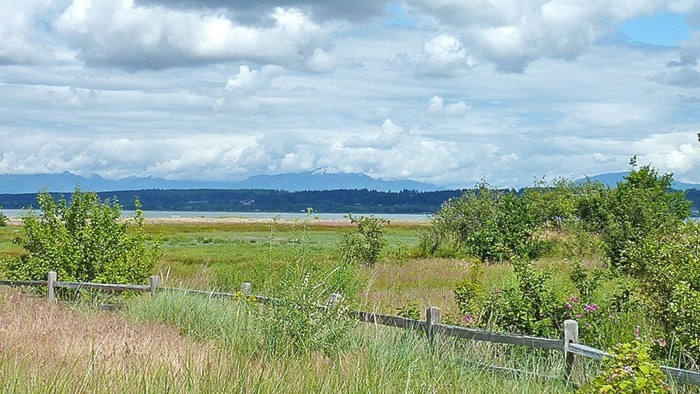Marshes and mud flats are among the most productive wildlife habitats on the planet, yet their value is often poorly understood.
Despite international wildlife designations and official protection as Wildlife Management Areas, the Fraser delta foreshore is at risk. Such impacts as invasive species and port development diminish the viability of critical habitats.
Not all marshes and mud flats are the same.
Extensive marshes of sedges, bulrushes and cattails line the shore between Brunswick Point and Richmond, prime habitat for snow geese and trumpeter swans. This is the active front of the delta, strongly affected by freshwater from the Fraser.
Nearby, brackish mud flats on Roberts Bank have areas of biofilm, a surface layer of bacteria and diatoms that is an important food for western sandpipers. Sandpipers slurp it into their bills during migration rest stops, in a style known as “snot-feeding.”
Boundary Bay’s waters, shielded by the Point Roberts peninsula, are much saltier, and the shoreline has the last small remnants of what were once extensive salt marshes.
Plants such as Salicornia (sea asparagus), sea arrowgrass, and orache flourish here, as well as the invasive cordgrass, Spartina.
In July, brightly coloured strands of the parasitic plant, salt marsh dodder, look like orange spray paint. Great blue herons roost and feed, and thousands of dabbling ducks gather in fall and winter.
With the lower part of the beach inundated by the tide twice daily, life there is adapted to salt water. Nearer the dyke, the marsh is awash only during the highest, stormiest tides, so a wider variety of species can flourish.
Canadian goldenrod, Douglas’ aster and gumweed brighten the Boundary Bay foreshore in late summer. Rodents, such as Townsend’s vole, attract many birds of prey.
Strong winter tides reshape the landscape, sending waves crashing over the dykes, tossing giant logs into piles and moving sand around.
This is well illustrated by the numerous changes undergone by the Beach Grove lagoons.
Semiahmoo Bay has deep marine waters, eelgrass beds and wide sandy beaches, all of which provide valuable wildlife habitat.
Freshwater marshes are found at the mouth of the Little Campbell River, a favourite haunt of waterfowl.
The backshore area, once deeply forested and with many freshwater springs and streams descending from the hills, was lost to development with the coming of the railway.
Mud Bay, at the eastern end of Boundary Bay, is influenced by the freshwater of the Serpentine and Nicomekl Rivers.
This was once the scene of a thriving oyster industry, destroyed by water pollution. Pacific oysters, an introduced species, still grow in abundance at the mouth of the Serpentine.
Sheltered tidal marshes around Blackie Spit at the mouth of the Nicomekl are important for migratory birds, including locally rare birds like long-billed curlew, marbled godwit and nesting purple martins.
The varied wetland habitats in the Fraser delta are a key reason for the number and diversity of birds found here. Birds do not fly around at random – they are often faithful to precise locations. That is why local birdwatchers know where to look for mountain bluebirds in spring, snowy owls in irruption year winters, and rare shorebirds in late summer.
Our marshes and mud flats are complex, vital ecosystems.
We must treat them with great respect.
Anne Murray, the author of two nature books available in local book stores, writes monthly in the Peace Arch News – www.natureguidesbc.com
